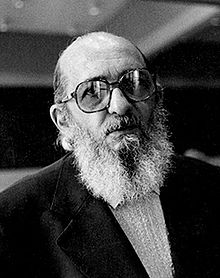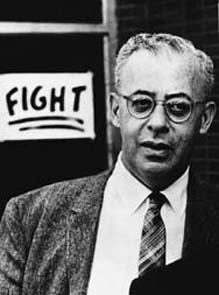
Paulo Friere. Source: https://en.wikipedia.org/wiki/Paulo_Freire

Saul Alinsky. Source: https://en.wikipedia.org/wiki/Saul_Alinsky
The Role of a Community Organizer: One Who Agitates & Educates
According to Saul Alinsky, a community organizer who advocated for more confrontational organization tactics, the organizer’s role is:
- “…That of an outsider who agitates, listens to the concerns of the people, and then mobilizes them” (Martinson & Su, 2012, p. 60).
- Like a fan to the flame of a community’s discontent. Their role is to ignite a desire to mobilize within a community by poking and prodding until the community sees organizing as necessary for achieving change.
Similarly, Paulo Freire, an adult educator who focused on “making people the subjects of their own learning” (Martinson & Su, 2012, p. 65), the role of an organizer is:
- Akin to an agitator, but in a quieter manner; a Frierian organizer fans the flame in a less confrontational approach.
- A “facilitator [who] engages participants by asking questions about how the problems they have identified affect their daily lives… and what actions they might take to address the problem[s] and thereby transform their reality” (Martinson & Su, 2012, p. 67).
- Someone who directs a community’s conversation in a direction that will lead to self-reflection, realization of the problem, and an eventual desire to take action and transform society.
Educating a Community Organizer: Aspects & Difficulties
The process of training community organizers is complicated and requires experience, diligence, and dedication. Often, the process is arduous; Saul Alinsky said, “As I look back on the results of those years [of teaching], they seem to be a potpourri, with… more failures than successes” (Alinsky, 1971, p. 65). Aspects of the educating process include:
- “Frequent long conferences on organizational problems, …[and] the education and development of community leaders” (Alinsky, 1971, p. 64)
- Teaching experience via “construct[ing] experience for students” (Alinsky, 1971, p. 68) and “shov[ing] those happenings back into the student’s system so [they can] digest them [as] experience” (Alinsky, 1971, p. 69).
Further, difficulties of this process include:
- Teaching students to be adaptable organizers. It is not easy for people to transition from one arena of organizing to another. For example, campus activists who were able to assemble large numbers of students were “utter failures when it came to trying to communicate with and organize lower-middle-class workers” (Alinsky, 1971, p. 66).
- The reality that some of the traits organizers needed to possess are not teachable (ie. adaptability, experience).
- Trying to teach past some student’s experience with institutionalized training – essentially “formalized garbage” (Alinsky, 1971, p. 68) according to Saul Alinsky.
The Possibilities
There are many difficulties involved in trying to educate community organizers, however it is not impossible. As long as “the organizer finds his goal in creation of power for others to use” (Alinsky, 1971, p. 80), she/he will be able to organize successfully. Certainly, the most important part of being an effective community organizer is having the willpower to fully dedicate to a community and rally around an issue, all in the name of benefiting the social good. So despite their training, if at the heart of an organizer is a desire to put their whole self on the line in order to create power for others, they have high chance of becoming an effective community organizer.
